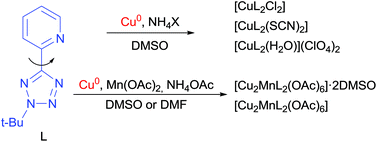2-tert-Butyl-5-(2-pyridyl)-2H-tetrazole as a chelating ligand in the direct synthesis of novel Cu(ii) and heterobimetallic Cu(ii)/Mn(ii) complexes†
Abstract
For the first time, a representative of the 2,5-disubstituted tetrazoles, namely, 2-tert-butyl-5-(2-pyridyl)-2H-tetrazole (L), has been found to participate in oxidative dissolution of copper powder in homometalic systems Cu0–L–NH4X–DMSO (X = Cl, SCN, ClO4) and heterobimetallic ones Cu0–Mn(OAc)2–L–NH4OAc–Solv (Solv = DMSO, DMF), providing the formation of molecular homometallic complexes [CuL2Cl2] (1), [CuL2(SCN)2] (2), and [CuL2(H2O)](ClO4)2 (3), heterobimetallic complex [Cu2MnL2(OAc)6] (4) from DMF solution and its mixture with complex [Cu2MnL2(OAc)6]·2DMSO (5) from DMSO solution. Free ligand L and complexes 1–4 were characterized by elemental analysis, IR spectroscopy, thermal and X-ray single crystal analyses, whereas complex 5 was characterized by X-ray analysis only. Compounds 1–3 are mononuclear complexes, with chelating coordination mode of L via the tetrazole ring N4 and pyridine ring N7 atoms. Heterobimetallic complexes 4 and 5 possess trinuclear structures, with a linear Cu–Mn–Cu arrangement of the metal atoms, linked by the acetate anions; each copper(II) atom is decorated by a chelating unit of L via the tetrazole ring N1 and pyridine ring N7 atoms in complex 4, and via the N4, N7 atoms in complex 5. Temperature-dependent magnetic susceptibility measurements of complex 4 revealed a weak antiferromagnetic coupling between the paramagnetic copper(II) and manganese(II) ions (J = −2.5 cm−1, gCu = 2.25 and gMn = 2.01), with magnetic exchange through the acetato bridges.


 Please wait while we load your content...
Please wait while we load your content...